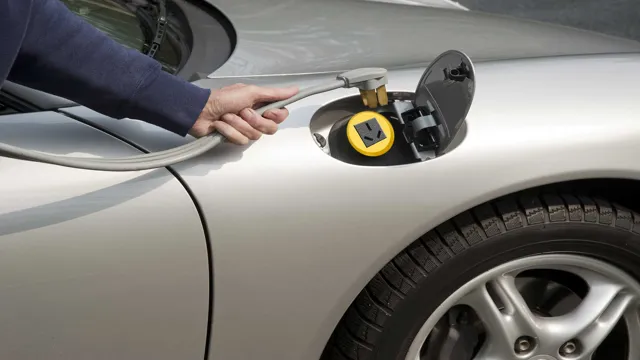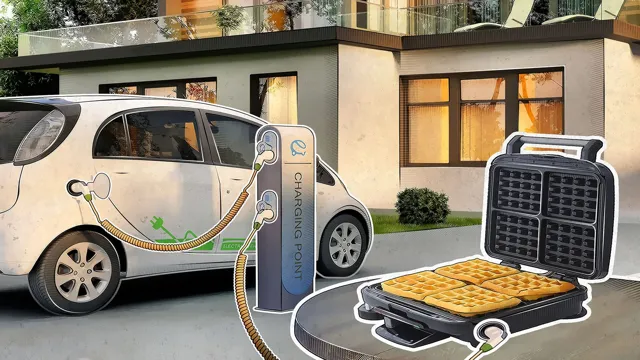Electric Car Charging: The Ultimate Guide to Powering Up Your Ride!
Is your curiosity piqued about the world of electric cars? From Tesla to Chevrolet Bolt and Nissan Leaf, electric vehicles (EVs) are becoming more popular among drivers who want to reduce their carbon footprint and save money on gas. However, one of the biggest concerns associated with owning an EV is charging, especially for first-time EV drivers. In this beginner’s guide, we’ll break down everything you need to know about charging electric cars, from the types of charging stations and cables to the different charging speeds and how to find charging stations on the go.
Get ready to take the first step towards a more eco-friendly driving experience!
Introduction
Are you considering purchasing an electric car but unsure about the charging process? Look no further, as this guide to charging electric cars will provide you with all the information you need to know. One of the main advantages of an electric car is its low operating costs, with charging being significantly cheaper than filling up a tank with gasoline. There are three main types of charging: Level 1, Level 2, and DC fast charging.
Level 1 charging can be done at home using a standard 120-volt outlet and provides a range of around 2-5 miles per hour of charging. Level 2 charging requires an electrician to install a 240-volt charging station and provides a range of around 10-60 miles per hour of charging. DC fast charging is the quickest but typically requires a specific charging station and can provide up to 80% charge in around 30 minutes.
It’s important to note that the charging speed will vary based on the battery size and type of electric car. With this guide to charging electric cars, you’ll be able to make informed choices and enjoy the benefits of driving an electric vehicle.
Benefits of owning an electric car
Electric cars have been on the rise in recent years, and their popularity only seems to be increasing. There are several benefits to owning an electric vehicle that make them an attractive option for many drivers. One of the main advantages is their efficiency.
Electric cars are much more efficient than traditional gasoline-powered vehicles, which means they require less energy to travel the same distance. This translates to lower fuel costs and a reduced carbon footprint, making them an environmentally friendly choice. Plus, with advancements in technology, electric cars have longer ranges than ever before, making them a practical option for everyday use.
With all of these benefits, it’s no wonder why electric cars have become a popular choice for drivers looking to reduce their impact on the environment while still enjoying the convenience of owning a car.

Different types of EV charging
Electric vehicle charging infrastructure has been growing rapidly in recent years, leading to many different types of charging stations for EV drivers to choose from. Depending on their needs, drivers can opt for different types of charging that vary in cost, speed and availability. From slow trickle charging at home to ultra-fast DC charging at public stations, there are several levels of EV charging available on the market.
EV owners should do their research and consider factors such as charging time, battery capacity and driving range before choosing which type of charging they want to use. Adopting eco-friendly technology is the need of time and going for EV and choosing a suitable charging station can protect our planet while saving hard-earned money on fuel costs.
Charging at Home
Are you considering buying an electric car and wondering how to charge it at home? Well, you’ve come to the right place! When it comes to charging electric cars, the two most commonly used chargers for home charging are level 1 and level 2 chargers. Level 1 chargers plug into a standard 120-volt outlet and can provide up to 4 miles of range per hour of charging. They’re generally the slowest option, but they can be a good choice for people who don’t drive a lot or have access to charging at work.
On the other hand, level 2 chargers require a 240-volt outlet and can provide up to 25 miles of range per hour of charging. This means they can fully charge an electric car in about 8 hours, depending on the car’s battery size. A level 2 charger is typically the best option for drivers who use their cars frequently and need to charge quickly at home.
But before you buy a charger, make sure to check if your electric car has a built-in charger or if you need to purchase one separately. With the right charger and a little planning, charging your electric car at home can be convenient, cost-effective, and environmentally friendly.
Installing a home charger
Installing a home charger for your electric vehicle (EV) is an excellent way to ensure that you can always have a full battery when you need it. The process is relatively straightforward, but it does require some technical knowledge. First, you need to choose the right charger for your EV model and your home’s electrical system.
Consider the amperage, voltage, and charging speed of different chargers. Once you have the charger, you need to install it in a safe and easily accessible location. It should be protected from the elements and away from flammable materials.
You will also need to have a licensed electrician install a dedicated circuit and outlet for the charger. This ensures that your home’s electrical system can handle the charger’s power demand and reduces the risk of overload or a fire. After the charger is installed, you can start using it to charge your EV in the comfort of your own home.
Having a home charger is convenient, saves you money in the long run, and is essential if you plan on owning an electric vehicle.
Cost of home charging vs public charging
When it comes to charging an electric vehicle, most drivers rely on home charging stations. Home charging is convenient, cost-effective, and allows you to have a fully charged vehicle each morning. The cost of home charging varies depending on the type of charger you use and your electricity rate.
On average, you can expect to spend around $0.12-$0.16 per kWh for home charging.
This is significantly cheaper than public charging stations, which can cost up to $0.50 per kWh or more. In addition, you can take advantage of off-peak hours to further lower your charging costs.
Overall, home charging is a practical and affordable option for EV owners and allows you to save money in the long run.
Public Charging Stations
If you’re thinking of switching to an electric car, it’s important to understand how public charging stations work. These stations are typically located in public spaces such as parking lots, shopping centers, and highway rest areas. The charging process can take anywhere from 30 minutes to several hours depending on the type of charger and your vehicle’s battery capacity.
To use a public charging station, simply plug in your car and wait for it to charge. Some stations require a payment, either through a membership program or a credit card, while others may offer free charging. To find public charging stations in your area, you can use an app or website that shows local charging options.
Planning ahead and knowing where charging stations are located can help you avoid any range anxiety and ensure a smooth and convenient driving experience.
Finding public charging stations
Public charging stations are becoming more common as electric vehicles gain popularity. But where do you find them? Luckily, there are quite a few apps and resources available to help locate charging stations. One popular app is PlugShare, which has a map of charging stations around the world and lets users rate and review them.
Another option is ChargePoint, which has its own network of stations and allows users to search for free or paid stations based on their location. Many car manufacturers also offer their own charging station locators, such as the BMW ChargeNow app or the Tesla Supercharger map. Additionally, some navigation systems, like Google Maps, now include charging station locations as well.
With these resources at your disposal, finding a public charging station for your electric vehicle should be a breeze.
Using public charging stations
As electric vehicles become increasingly popular, the need for public charging stations is also on the rise. Public charging stations are convenient for electric vehicle owners who need to top up their battery while out and about. When using public charging stations, it’s important to keep in mind a few things.
First, make sure you have the correct cable and connector for the station you are using. Different stations may require different cables. Second, be prepared to wait for other electric vehicle owners to finish their charge.
Some popular stations may have a queue, so plan accordingly. Lastly, always be mindful of your surroundings and keep an eye on your vehicle while it is charging. Overall, public charging stations can be a great resource for electric vehicle owners, allowing them to travel longer distances with peace of mind.
Fast Charging vs Slow Charging
When it comes to charging your electric car, there are two main types: fast charging and slow charging. Fast charging, as the name suggests, is a process that quickly charges your car’s battery, allowing you to get back on the road in no time. This type of charging typically utilizes a high-voltage DC charging station, which can deliver up to hundreds of miles of range per hour.
On the other hand, slow charging takes more time to fully recharge your car’s battery. It is often done via a standard home outlet or a Level 2 charging station and can take anywhere from a few hours to overnight. The advantage of slow charging is that it puts less stress on your battery, which can prolong its lifespan and reduce the risk of damage.
Ultimately, the type of charging you choose depends on your specific needs and lifestyle. If you’re on a road trip or have a busy schedule, fast charging may be the better option. But if you’re charging overnight at home or have a less urgent need for power, slow charging may be the more convenient and practical choice.
Either way, always ensure that you have a charging plan in place to prevent running out of power on the road.
How long does it take to charge an EV?
When it comes to charging an electric vehicle (EV), there are two options: fast charging and slow charging. The time it takes to charge an EV will depend on which method you choose. Fast charging can typically charge an EV from 0-80% in 30-45 minutes, while slow charging can take anywhere from 6-12 hours.
It’s important to note, though, that not all EVs are compatible with fast charging and the charging time may vary depending on the model and battery size. Additionally, fast charging may cost more than slow charging, so it’s worth considering which charging option is best for your lifestyle and budget. Overall, both fast and slow charging options provide convenient ways to keep your EV charged and ready to hit the road.
Which charging option is right for you?
Are you planning to buy an electric vehicle and wondering which charging option is right for you? Let’s talk about fast charging vs slow charging. Both options are designed to increase your EV’s battery power, but the key difference lies in the time taken to recharge your car. As the name suggests, fast charging can recharge your EV’s battery within minutes, but it requires a higher electric power supply, making it best for long-distance driving or emergency situations.
On the other hand, slow charging takes a longer time to recharge, but it is more energy-efficient and cost-effective, making it an excellent option for daily use or overnight charging. It’s essential to note that fast charging can also reduce your EV battery’s lifespan due to the high currents used during the charging process. So, which option is best for you? It ultimately depends on your driving needs and lifestyle.
If you regularly travel long distances and need quick recharging, fast charging is your best bet. However, if you drive short distances daily, slow charging is a cost-effective and convenient option.
Conclusion
In conclusion, charging an electric car is not rocket science, but it does require a little bit of know-how. Just like fueling up a traditional car, it’s important to find the right charging station, plug in correctly, and monitor the charging progress. The difference? With an electric car, you’ll never have to visit a gas station again, and you’ll be doing your part to reduce emissions and help the environment.
So, next time you hit the road with your electric vehicle, remember to charge up, sit back, and enjoy the ride (with a clear conscience)!”.
FAQs
How long does it take to charge an electric car?
The charging time for electric cars depends on the battery size, charging level, and the charging equipment used. On average, it takes 4-8 hours to charge an EV with a Level 2 charging station.
Do I need a special power outlet to charge my electric car?
You can charge your electric car using a standard 120V household outlet, but it will take longer to charge. For faster charging, you need a Level 2 charging station that uses a 240V outlet.
Can I charge my electric car in rain or snow?
Yes, you can charge your electric car in any weather condition as long as the charging equipment is installed and rated for outdoor use.
How much does it cost to charge an electric car?
The cost of charging an electric car depends on the electricity rates in your area and the battery size of your car. On average, it costs around $0.11 – $0.15 per kilowatt-hour to charge an EV.



